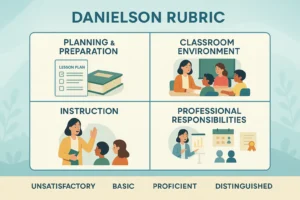Making the switch to online learning is not only difficult for students, but also for instructors as well. Online learning presents a new set of challenges that are not present for traditional schemes of in-person learning. How can administrators support teachers during this transition period, and what can they do to improve the effectiveness of online instruction?
When it comes to teacher motivation, self-efficacy is an important concept. Self-efficacy refers to the belief of individual teachers that they can succeed with a specific project or task. Teachers that report low self-efficacy are less confident in their efforts as a teacher and might be less motivated as a result.
As one might expect, feelings of self-efficacy are tied to student performance. As such, when it comes to online learning, improving teacher self-efficacy will lead to students flourishing in this new digital learning environment.
As administrators, our job is not only to make sure that teachers are meeting performance metrics, but also to make sure that they get the support and help they need. Administrators can provide resources for teachers to help improve self-efficacy and improve student outcomes. Here are some choice ways that administrators can work with teachers during the transition to online learning.
Provide Feedback on Lessons and Activities
Many teachers who are new to online learning might find difficulty translating their teaching methods to an online format. Administrators can ease this transition by providing thorough feedback on teaching materials and activities. When assessing materials, it is important for administrators to look for things like student accessibility. This includes whether lessons are readily available on multiple devices, how students can interact with the material, and whether learning materials meet target requirements and teaching points.
Given the different nature of the medium, it can be hard for teachers to know if their online materials are meeting state and district-mandated standards. Administrators can assist teachers by providing solid feedback on their lesson plans and offer advice on how to better adapt lesson plans to the digital sphere.
Co-planning for Lessons
Teaching is not a solo enterprise and is a collaborative effort between teachers and other instructors as well as teachers and administrators. The fast transition to online learning has a steep learning curve which many teachers may not be ready to handle on their own. Administrators can ease the burden of this transition by allowing teachers to co-plan synchronous materials.
The benefits of co-planning are apparent. First, co-planning allows multiple teachers to work on lesson plans and provide their own strengths and insights. One teacher might have methods that another does not, and their ideas can work together and reinforce one another. Teachers working together can help them cover each other’s blind spot and distributing the workload helps improve feelings of collaboration and professional relationships among educators.
Responsive Professional Learning
One of the most effective ways to improve self-efficacy in teachers is to give them space where they can master a task. When it comes to digital learning specifically, teachers need support for learning about the new technologies that they will be using for instruction. Responsive professional learning is a method to give teachers a place where they can take risks but also set them up for success.
For example, online teachers can greatly benefit from workshops that instruct how to plan and administer online curricula. Teachers can receive individualized support for any technical issues as they are learning the ropes of any new teaching software or technologies. By breaking the learning of these systems into smaller chunks, teachers can feel like they are improving the mastery of these various systems, and thus feel more confident applying them in online instruction.
Flexibility in Planning Is Actually Good
In-person instruction is typically characterized by strict criteria and standards of evaluation. As many teachers are learning, transplanting these methods and structures to an online environment is often difficult or just does not work, whether it is because of the nature of online education or the nature of student-teacher interaction in an online environment.
Instead of encouraging teachers to continue with the same methods of instruction they have been using, teachers should be encouraged and incentivized to experiment with different methods of lesson planning. Given the novelty of mass online learning, the primary focus is keeping students engaged in a new learning environment, as there are no nationwide standards for online learning. Changing from traditional patterns of planning instruction can help keep student engaged and prevent them from completely falling off the path
Social and Emotional Learning
According to a survey performed by the Yale Center for Emotional Intelligence, the most common emotions teachers across the US reported feeling during the COVID-19 crisis have been anxiety, fear, worry, overwhelmed, and sad. The vast majority of respondents linked these emotions to the stress around managing their new teaching environment.
It is well known that teacher emotions have a great effect on teaching outcomes and the conduct of teachers. Emotions matter for decision-making, attention, and professional relationships. Social and emotional learning (SEL) can be a conduit to help stressed teachers manage their emotions during the transition to online learning. Administrators can support teachers by providing more opportunities to improve teachers’ emotional lives.
Additionally, teachers that work in institutions with administrators who demonstrate a high degree of emotional skills experience a more positive atmosphere at work. To that end, administrators should make a greater effort to focus on and improve the emotional well-being of teachers as they move through this turbulent time. A focus on SEL is one way to do this.
Conclusions
Online learning has changed the face of education, potentially for good. As online education becomes the norm, administrators need to realize the importance of supporting teachers in their professional and emotional lives. Administrators have the resources and tools to make sure that teachers are successful. It is a matter of making sure that teachers have access to those resources and tools that can make all the difference.



